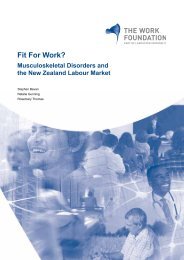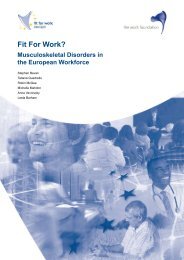FfW Bulgarian report (English language) - Fit for Work Europe
FfW Bulgarian report (English language) - Fit for Work Europe
FfW Bulgarian report (English language) - Fit for Work Europe
Create successful ePaper yourself
Turn your PDF publications into a flip-book with our unique Google optimized e-Paper software.
3.5<br />
Summary<br />
<strong>Work</strong> and MSDs in Bulgaria<br />
Lundkvist, Kastäng and Kobelt (2008) found that the total cost of treating RA patients in Bulgaria<br />
was 2,825 euros per patient per year resulting in 144 mln euros overall costs. A later estimation<br />
by Kobelt and Kastaeng (2009) concluded lower RA costs of 2,063 euros per patient per year,<br />
or 61.3 mln in total. These included medical costs, drug costs, non-medical costs, the costs of<br />
in<strong>for</strong>mal care and other indirect costs, but do not differentiate between those of working age and<br />
those above retirement age. These figures are significantly lower, per patient, than those <strong>for</strong><br />
other Western <strong>Europe</strong>an countries, but comparable to the Eastern <strong>Europe</strong>an average.<br />
The limitations of data collection outlined above highlight some of the difficulties encountered in<br />
trying to cost the impact of MSDs <strong>for</strong> employers and society.<br />
In this section we have considered the impact that MSDs have on a person’s ability to work,<br />
both physically, as a result of the condition itself, and from the associated effects, such as<br />
loss of concentration from pain. We have also discussed the impact that the workplace can<br />
have on MSDs, both at onset and during the development of the conditions. Whilst there are<br />
many intrinsic risk factors <strong>for</strong> MSDs it is clear that the workplace has the potential to expose<br />
employees to other risk factors, both physical and psychosocial. Some of the well-established<br />
workplace risk factors such as vibrations and workstation ergonomics are already recognised<br />
by many employers. However, the impact of other workplace risk factors such as job quality and<br />
support of disclosure, are not as widely understood.<br />
We have also highlighted that it is important to distinguish between risk factors <strong>for</strong> the onset of<br />
MSDs and risk factors <strong>for</strong> chronic illness and disability. Whilst the physical conditions of work<br />
may cause or aggravate musculoskeletal symptoms, the impact or outcome on individuals<br />
(absence from work and disability) is strongly associated with psychosocial factors (Waddell and<br />
Burton, 2006b).<br />
Finally, we have looked at the economic and social impact of MSDs and have discussed the<br />
direct, indirect and total costs of MSDs. Direct costs of MSDs among the working age population<br />
were estimated at just over 46 million euros. Un<strong>for</strong>tunately, total cost estimates as found in the<br />
literature do not take into account the enormous intangible costs born by people with MSDs.<br />
This is due to the difficulty of expressing intangible costs in monetary terms. Total overall<br />
costs of RA were found to be 61.3 million euros <strong>for</strong> all patients over 19 years old. However,<br />
data <strong>for</strong> RA in particular, point out how direct and indirect costs increase with the progression<br />
of the disease. As a consequence, the development of strategies and interventions to stop<br />
this progression and ensure that those with MSDs are supported to enjoy full and productive<br />
working lives appears necessary. The next section will discuss <strong>for</strong> each condition the most<br />
common and appropriate interventions outside and within the workplace.<br />
<strong>Fit</strong> For <strong>Work</strong>? 41







